#Festival celebrated in Nepal
Explore tagged Tumblr posts
Text
Festivals In Nepal You Must Experience
Nepal is one of the few diverse country with many differences in nature, culture, religion, lifestyle, etc. Every village in Nepal values its traditions in a unique way. Many of these traditions are centuries old and are done for specific purposes. Every country respects the culture of other countries. This is the main reason for the harmonious way of life in Nepal. Despite its small size, the Himalayan nation is home to many different cultures and tribes with different traditions and rituals. Because of their different ethnic groups, the Nepalese people have different beliefs and customs. Despite this, everyone is united for the celebration of the great festivals. Festivals like Dashain and Tihar are nationally important; like Indra Jatra or Rato Machchhendranath Jatra, which belongs to the ancient village culture of the valley, but others are only seen by one tribe. The cultural diversity of Nepal can be seen in the various festivals that are celebrated in the country. However, there are lots of festivals in Nepal, which are also popular with tourists from different parts of the world. To take a closer look at the diversity of Nepal, here is a list of festivals in Nepal.
Dashain
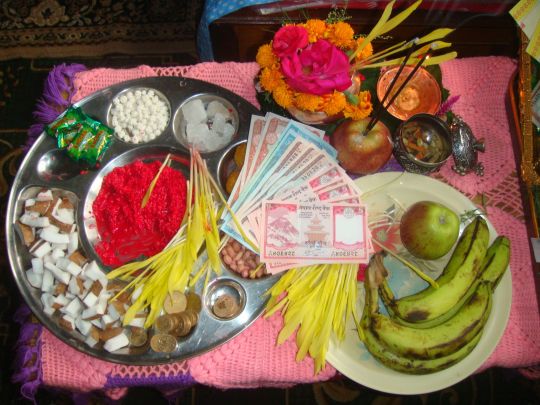
Dashain is one of the biggest and most popular festival of Hindu. Dashain is the festival of Goddess Durga's victory over the evil Mahishasura, according to Hindu mythology. Nepalese people celebrate Dashain for fifteen days by spending time with their family members eating delicious food and receiving tika and blessings from elders. It is one of the few festivals celebrated by many people of Nepal. The first day of Dashain is celebrated as Ghatasthapana, the beginning of the festival. People worship the eight tantric goddesses on the first day and the next nine days are dedicated to each form of Durga.
Tihar
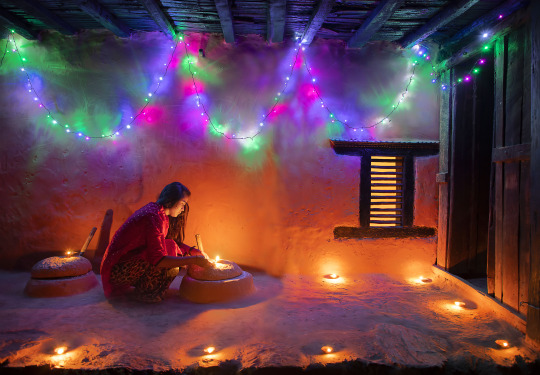
After Dashain Tihar is another biggest festival of Hindu which is right after Dashain. Tihar is celebrated for five days. The first two days are celebrated with the worship of crows and dogs. On the third day, people sprinkle crackers and light small clay lamps in their homes. On the fourth day, cows are worshiped in the morning, and in the evening you can watch the special Govardhan Pooja. If you visit the Newar community, the fourth day is celebrated as Mha Puja, the New Year. The last day is Bhai Tika (Brothers' Day). This ceremony is done between the brothers and sisters of the family. Sisters pray for the welfare of their brothers and apply tika on their foreheads for long life. On the other hand, brothers give their sisters sweets and gifts. They follow special rituals during this festival.
Teej
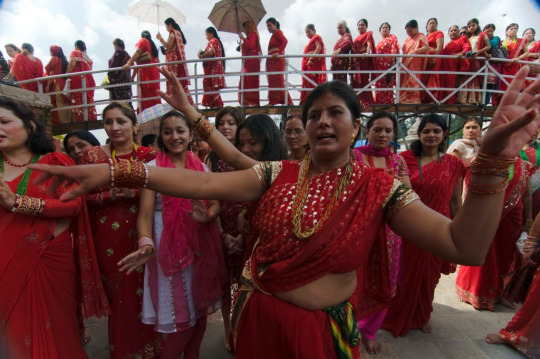
Teej is one of the biggest festivals in Nepal, celebrated by women. Traditionally, it is a great day for married women, who visit their mother's house and eat a traditional meal called Dar. After Dar, women fast for a whole day without eating or drinking while singing and dancing in groups. Many women go to Pashupatinath to pray. Teej is celebrated for three days. On the first day, married women fast and perform rituals for the well-being and health of their husbands. Single women fast for the blessings of a happy married life in the future. During the next two days, you can enjoy many special rituals performed by Lord Shiva and Lord Parvati. You can enjoy cultural events, special food, and many more things. During Teej, women wear red saris, tikas, and bangles, and sing and dance for days. What is interesting is to see women of all ages gathered together, young and old, dancing for hours in the heat, in the rain without a single drop of water or food for a whole day.
Fagu Purnima/Holi

Fagun Purnima, also known as Holi, is named after the goddess Holika. Like many other festivals in Nepal, Holi is also linked to Hindu mythology. According to legend, a young man named Prahalad was a devotee of Lord Bishnu, who was considered a mortal enemy by his father, the demon king Mahisasur. Filled with rage, the Demon King commissioned his sister Holika, who possessed a flamethrower, to kill his son. After that, Holika sat in the fire holding Prahalad, but she died in the fire while the boy was alive. And to celebrate this glory, people play Holi, a festival of fun, color, and happiness. It said that it begins with the victory of good over evil. Holi has gained popularity among tourists. This festival is fun by splashing each other with colored water. Holi is celebrated on two different days. Nepal's northern regions perform it on the full moon day of February or March. Other Nepalese people do it on the day after the full moon day.
Chhath
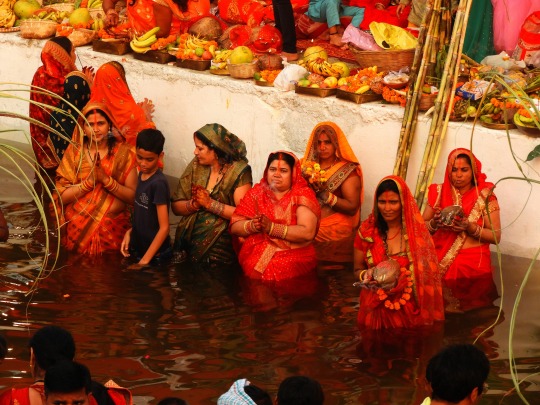
This festival is celebrated by the people of Mithila and the Terai people. The purpose of this celebration is to honor the Sun God for his mercy and light on people. The people fast during the day, praying for prosperity and wealth. After worshiping the sun, they had a feast. Other important rituals of this festival are holy immersion in the river, bathing in water, preparing special food for the Sun God, etc. After fasting, you can enjoy these foods. The best food to try during this festival is Anarsa and Thekuwa. Unfortunately, these dishes are not prepared during other seasons.
Buddha Jayanthi
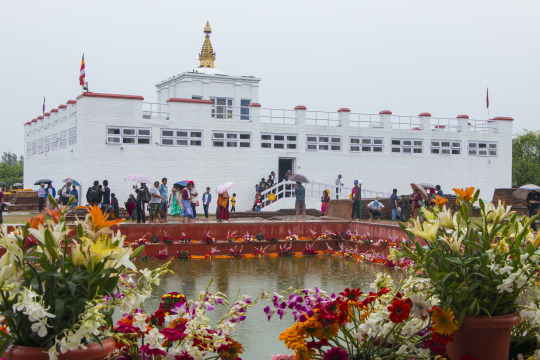
Buddha Jayanti is celebrated to remember the birth of Lord Buddha. Gautam Buddha was born in 623 BC as the head of the Shakya dynasty in Lumbini, Kapilvastu region of Nepal. Being the birthplace of Budhha, Nepal celebrates Buddha Jayanti as one of its major festivals. It falls on the night of the full moon of May or June. Peace lovers and Buddhist communities love to make their pilgrimage to the birthplace of Buddha, Lumbini of Nepal on this beautiful day. The main destination to visit during this festival is Lumbini. Many tourists visited Lumbini to see the birthplace of Lord Buddha. Watch many beautiful and interesting shows, led by monks and nuns.
Maghe Sankranti

Maghe Sankranti is celebrated on the first day of the Magh month of the Nepalese calendar. It is a reflection of the holy month, usually in the middle of January. This festival is expected to bring the end of winter and hopes for warmer weather and better days of health and wealth. On this day, the family gathers together to eat a delicious meal together. People eat sesame seed candies, ghee, molasses, sweet potatoes, and ji according to tradition. Also, the same day is observed as Maghi - New Year in Tharu village of Terai. People celebrate this festival with family gatherings, eating varieties of food, going to Melas, wearing traditional clothes, etc.
Indrajatra
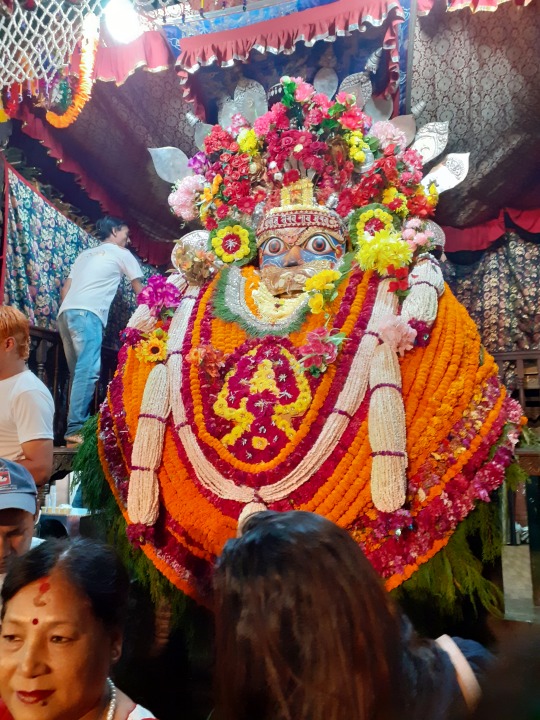
Indra Jatra is the festival of the Newar community in the Kathmandu Valley. It is an eight-day Jatra festival that falls in September. This festival also marks the beginning of the autumn moon festival season. It is done to remember when Indra came down to earth; According to Hindu mythology, Indra is the king of heaven. The chariot of the living goddess Kumari is taken through the streets of Kathmandu. Lots of people gather to enjoy the joyous procession led by masked dancers known as Lakhey.
Shree Krishna Janmashtami
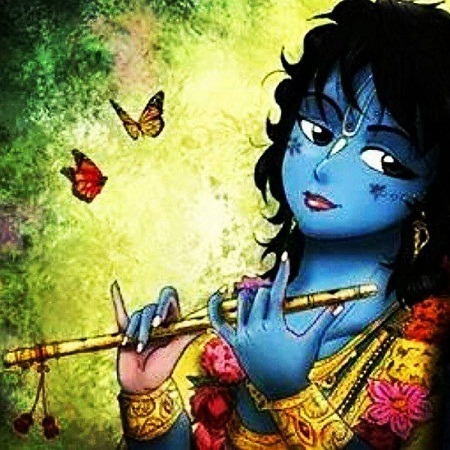
Shree Krishna Janmashtami celebrates the birth of Lord Sri Krishna. According to Hindu mythology, Lord Krishna is considered the 8th avatar or "incarnation" of Lord Vishnu, who was born to stop the wickedness of his uncle "Kansh". Lord Krishna was an evil deity who was involved in many misdeeds as a child, including breaking pots and stealing butter from villagers. Therefore, during Janmashtami, there is a ceremony where a pot of butter is hung on top, and different groups break the pot for delicious food.
Mahashivaratri
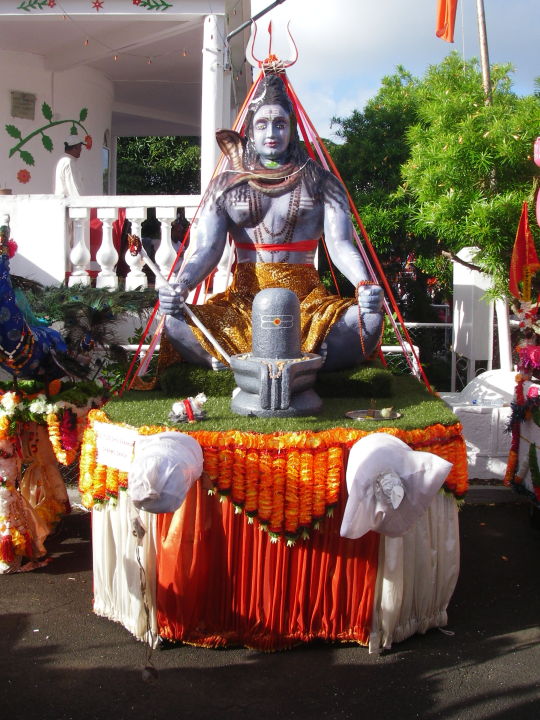
Mahashivaratri, or the night of Shiva, is one of the main festivals in Nepal. Lord Shiva is the supreme deity according to Hindu mythology. According to the belief of the day of Shivratri, the stars are in the best position which increases the spiritual power. On this day, thousands of Hindus visit the holy place of Hindus, Pashupatinath Temple, which is also considered the protector of the Kathmandu Valley in Nepal. During this festival, the Pashupatinath temple is decorated with flowers. Many Sadhus from India come to pray on Pashupati and perform the spiritual dance of Tandav of Lord Shiva on this day. As it is a nocturnal event, devotees celebrate the whole night, chanting and praying for light in the darkness. At home, people gather, light bonfires and prepare holy Shivratri food.
In Conclusion
Apart from these festivals, Nepal celebrates many other regional, national, and seasonal festivals. Since there are so many of them, every season of the year promises a rewarding experience. Make a plan for your trip with Alpha Adventure Treks to experience the exciting activities of Nepal. We are here to help you to find the best and perfect festival and unforgettable cultural tour in Nepal at your convenience.
0 notes
Text

Bhaktapur, Nepal
Dancers await their turn during the Nawa Durga Nach Hindu festival on the outskirts of Kathmandu
Photograph: Prakash Mathema/AFP/Getty Images
#prakash mathema#photographer#afp via getty images#bhaktapur#nepal#culture#dancers#nawa durga nach hindu festival#celebration#kathmandu
2 notes
·
View notes
Text
Sunlit Reverence: Celebrating Chhath Puja, the Ancient Festival of Devotion
Sunlit Reverence: Celebrating Chhath Puja, the Ancient Festival of Devotion As dawn breaks over the riverbanks of Bihar and the plains of northern India and Nepal, a beautiful, ancient tradition comes to life – Chhath Puja. This festival honours the Sun God (Surya) and his sister, Chhathi Maiya, embodying themes of purity, gratitude, and resilience. My own memory of this celebration is rich with…

View On WordPress
#Aging with Grace#Art of Living#Blogging#Contemporary Reflection#Culture#dailyprompt-2111#Divine Mercy#Education#Effective Life Style#English Literature#Faith#Festivals#Festivities#Indian Festivals Mythology & History Indian Philosophy Astronomical Insights Cultural Celebrations Political Events Introduction: The Vi#Philosophy post Retirement#Reflection#Saga#Spirituality#Story of Nepal
0 notes
Text
Discover Kukur Tihar: Nepal's Unique Dog Festival
Kukur Tihar is a special festival in Nepal dedicated to dogs. It is part of the larger Tihar festival, which celebrates different animals and is known as the “Festival of Lights.” This heartwarming event usually takes place in late October or early November, depending on the lunar calendar. A Brief History Kukur Tihar has been celebrated for centuries. It is believed that this tradition started…
#Animal Lovers#animals#Celebrate Dogs#Cultural Celebration#Dog Lovers#Dogs Of Nepal#Festival Of Lights#Festive Traditions#Kukur Tihar#nepal#Nepal Festivals#Nepali Culture#Pet Appreciation#pets#Tihar 2024
0 notes
Text

Wishing you and your loved ones a vibrant and joyous Holi! May this festival of colors fill your life with education, prosperity, and endless moments of laughter. Let the colors of Holi spread the message of peace and unity, and may you cherish wonderful memories with your friends and family. Happy Holi from all of us at WRC Nepal!
#wrcnepal#wrc#wide range consultancy#nepal#wrc nepal#happy holi#holi#holi celebration#festivals#festive
0 notes
Text
0 notes
Text

Nepalese women dance at the Pashupatinath temple during Teej festival celebrations in Kathmandu, Nepal, Friday, Sept. 6, 2024. (AP Photo/Niranjan Shrestha)
19 notes
·
View notes
Text
Kali - काली

Kali is a complex and powerful Hindu goddess known for her transformative, fierce, and protective qualities. She is often associated with destruction, time, death, and rebirth, but also with liberation and empowerment. Here’s a detailed look at Kali:
Origins and Background:
Name: Kali’s name comes from the Sanskrit word “Kala,” meaning time. She represents the inevitable nature of time, change, and transformation. In some interpretations, she is also linked to "black" or "dark," symbolizing the primordial void from which creation springs.
Origins: Kali is a form of the goddess Durga, who is often invoked for protection and strength. In Hindu mythology, she was born from Durga’s anger when the goddess needed an even more powerful force to defeat demons. Her energy (shakti) manifested as Kali, who easily destroyed the demonic forces threatening the world.
Region: Kali is venerated throughout India, especially in Bengal, Assam, and Kerala, as well as in Nepal. Her worship has spread globally due to her potent symbolism of power and liberation.
Iconography and Symbols:
Appearance: Kali is often depicted with dark skin (sometimes black or blue), wild hair, a fierce expression, and four arms. She typically holds a sword (symbolizing divine knowledge), a severed head (representing the ego), and a bowl (to catch blood, signifying life). She wears a necklace of skulls, a skirt of severed arms, and her tongue protrudes—often interpreted as her uncontainable nature.
Consort: Kali is often shown standing on the prostrate body of Shiva, her consort, symbolizing that even destruction (Kali) is subject to the higher cosmic order (Shiva). This represents the balance between creation and destruction.
Kali’s Attributes and Symbolism:
Destruction: Kali is often associated with the destruction of evil, ignorance, and ego. Her fierce form represents the dismantling of illusions and attachments, making space for transformation and rebirth.
Liberation (Moksha): Kali helps her devotees move beyond worldly illusions and ego-driven desires, leading to spiritual liberation. She helps destroy the barriers to self-realization, showing her aspect as a mother who can be both terrifying and nurturing.
Time and Death: Kali represents time (Kala), the unstoppable force that eventually brings about death and transformation. However, she is not death itself but the remover of the fear of death, showing that death is a part of the cosmic cycle.
How to Communicate and Work with Kali:
Approach with Respect: Kali’s energy is intense, so it’s essential to approach her with humility and sincerity. She is not a goddess to invoke lightly, as she may challenge you to confront deep truths about yourself and your life.
Offerings: Common offerings to Kali include red flowers (especially hibiscus), fruits, incense, and red clothing. Devotees also offer food, sweets, and liquor (such as rum) in some traditions.
Mantras and Prayers: One way to honor Kali is through mantras. A well-known mantra is “Om Krim Kalikayai Namah,” which invokes her protective and transformative energy. You can chant it during meditation or when seeking her guidance.
Meditation and Visualization: Meditate on Kali’s image, focusing on her fierce yet liberating nature. Visualize her cutting away the illusions or fears that hold you back. Though her energy is powerful, she ultimately provides protection and strength.
Days of Worship: In some traditions, Kali is worshiped on Saturdays or during the new moon (Amavasya), a time associated with endings and new beginnings. The most significant festival for Kali is Kali Puja, celebrated during the Hindu festival of Diwali, especially in Bengal.
Things to Consider When Working with Kali:
Transformation and Shadow Work: Kali often helps those who are ready to confront their own shadows—the parts of ourselves we hide or fear. Her energy can prompt deep introspection and release, which may be intense but is ultimately healing.
Facing Fear and Ego: If you work with Kali, you might find yourself in situations where you are forced to confront your fears or break down attachments to ego-driven desires. This can be uncomfortable, but it’s a path to personal growth and liberation.
Protection: Kali is a fierce protector of her devotees. If you are dealing with challenges, feeling vulnerable, or need courage, Kali’s energy can be invoked to help you stand strong and face adversity.
Destruction as Renewal: Kali’s destructive aspect is also about clearing away what no longer serves you. This could mean relationships, old patterns, or limiting beliefs. Working with her can bring about significant life changes.
How to Honor Kali:
Rituals: You can create a small altar to Kali, where you place her image or statue, alongside offerings. Light candles or oil lamps, and offer incense, reciting mantras or prayers.
Self-Reflection: Since Kali helps in breaking down the ego, engage in regular self-reflection. Journaling about your emotions, fears, and goals can be a powerful practice.
Facing Your Shadows: Work on facing your fears, and be open to Kali’s lessons about impermanence and transformation. Accepting difficult aspects of life (such as loss or failure) can be part of honoring her.
Serve Others: Since Kali is both a destroyer and nurturer, acts of service, especially toward those in need or suffering, can be a way of embodying her compassion.
Working with Kali Spiritually:
Caution with Intensity: Kali’s energy is transformative but intense. She can push you toward personal evolution quickly, sometimes in ways that may feel like you are being “torn down” to be rebuilt. It’s important to pace yourself, especially if you are new to working with her.
Respect the Process: Kali’s path is not one of instant gratification. The changes she brings may take time, and they might not be easy. Trust the process of transformation she initiates, even when it feels challenging.
Kali embodies both destruction and creation, fear and protection, chaos and balance. Her energy can be both deeply terrifying and incredibly liberating, and working with her offers the chance for profound personal and spiritual growth.
#kali#deities#dark goddess#underworld goddess#hinduism#hindu goddess#goddess#witchcraft#witch#witchy#witchblr
16 notes
·
View notes
Text
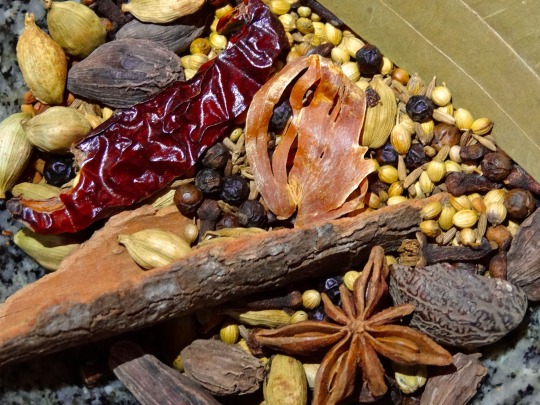
[ID: Close-up on whole spices including bark cinnamon, star anise, black cardamom, and mace in a granite mortar. End ID]
मीट मसाला / Meat masala (Nepali spice blend)
Nepali मीट मसाला or मिट मसाला ("mīṭ masālā" or "miṭ masālā," from "meat masala")—also called मटन मसाला ("maṭana masālā," "mutton spice blend")—is used to season various kinds of meat, but is especially common in marinades and sauces for lamb, as in खसीको मासु ("khasīko māsu," "lamb curry"). In Nepal, meat is usually eaten for parties or celebrations, on feast days—such as दसैँ (Dashain) and ईद अल-अधा (Eid al-Adha)—and on weekends.
Meat masala is sold as a commercial product to make home cooks' preparation of meat quicker and easier. In some recipes, the spice blend is not listed as a separate ingredient, but is hidden within the list and prepared fresh with each dish: depending on the cook, some of the spices will be left whole and fried in the cooking oil, and others will be toasted, ground, and added later.
Making your own meat masala gives you more control over the ingredients than buying commercially, and ensures a fresher product. Keep some in your pantry to add to meat preparations including curries, dumplings, and chatamari, and to use in marinades, sauces, and braises; or make a batch ahead of a festival and use it as the seasoning base for dishes you prepare over the course of the holidays.
Recipe under the cut!
Patreon | Paypal | Venmo
Ingredients
Spices for grinding
4 dried (3g) red chilis, or to taste (रातो खुर्सानी / rato khursani)
2 Tbsp (16.5g) cumin seeds (जीरा / jeera)
2 Tbsp (8.5g) coriander seeds (धनिया / dhaniya)
1 Tbsp (7g) green cardamom pods (सुकमेल / sukmel)
1 Tbsp (5g) black cardamom pods (अलैंची / elaichi)
1 Tbsp (8.5g) black peppercorns (मरिच / marich)
3-inch chunk (6.5g) Chinese cassia bark (दालचीनी क्यासिया / dalchini kyasiya)
1 tsp (2.5g) whole cloves (ल्वाङ / lwang)
1/2 head (2.5g) nutmeg (जायफल / jaiphal)
1 tsp (4.5g) fenugreek seeds (मेथी / methi)
1 tsp (2.5g) fennel seeds (सौंफ / saumph)
1 pod (1g) star anise (स्टार ऐनीज़)
1/2 tsp (1.5g) ground turmeric (बेसार / besar)
1/2 head (.3g) mace (जावित्री / javitri) (optional)
Look for cassia (cinnamon) bark that is rough and wood-like in appearance and does not curl naturally into quills: it may be labelled "cassia bark," "cinnamon stick flat," "desi cinnamon," or "dalchini flat" at a South Asian or halal grocery store.
Black cardamom pods may be labelled "kali elaichi" or "moti elaichi."
Spices for frying
2 medium (.7g total) tej patta (Nepal bay leaves) (तेजपात)
1 tsp (2g) ground ginger (अदुवा / adhuwa)
You may choose to leave out the spices for frying if you will be making a curry (and can fry them along with the rest of the aromatics). Include them for a preparation where the meat will not be fried in oil (e.g. momos, chatamari).
Instructions
1. Lightly crush nutmeg in a mortar and pestle to break in half. Crush cinnamon to break into a few pieces.
2. In a dry skillet over medium heat, roast chilis, black and green cardamom pods, and cinnamon until fragrant, stirring often. Set aside to cool.
3. Roast black peppercorns, cloves, and star anise for a couple minutes until fragrant. Set aside.
4. Roast smaller seeds (cumin, coriander, fenugreek, fennel), mace, and tej patta for a minute until fragrant. Set aside.
5. Remove skillet from heat. Toast turmeric and ginger for 30 seconds, stirring constantly.
6. Grind all spices together in a mortar and pestle or spice mill. Pass through a fine mesh sieve. Store in an airtight container in a cool place.
30 notes
·
View notes
Text

The next full moon is a supermoon blue moon
The next full moon is a supermoon, a blue moon; the sturgeon moon; the red, corn, green corn, barley, herb, grain, or dog moon; Raksha Bandhan or Rakhi Purnima; and Tu B'Av.
The full moon will be Monday afternoon, August 19, 2024, at 2:26 PM EDT. This will be Tuesday morning from Nepal Standard Time eastward across the rest of Asia and Australia to the International Date Line. The moon will appear full for three days, from Sunday morning through early Wednesday morning.
This will be a supermoon. The term "supermoon" was coined by astrologer Richard Nolle in 1979 as either a new or full moon that occurs when the moon is within 90% of its closest approach to Earth. Since we don't really see new moons, what has caught the public's attention are full supermoons as they are the biggest and brightest full moons of the year. This will be the first of four consecutive supermoons this year (with the full moons in September and October virtually tied for the closest of the year).
Although it will not look blue, as the third full moon in a season with four full moons, this will be a blue moon. The first recorded use of "blue moon" in English dates from 1528. Speculations on the origin of the term include an old English phrase that means "betrayer moon" (because it led to mistakes in setting the dates for Lent and Easter). Or it may be a comparison to rare events such as when dust in the atmosphere makes the moon actually appear blue. Since the 1940's the term "blue moon" has also been used for the second full moon in a month that has two full moons.
The Maine Farmer's Almanac began publishing "Indian" names for full moons in the 1930s, and these names have become widely known and used. According to this almanac, for the full moon in August, the Algonquin tribes in what is now the northeastern U.S. called this the sturgeon moon after the large fish that were more easily caught this time of year in the Great Lakes and other major bodies of water. Other names reported for this moon include the red moon, the corn or green corn moon, the barley moon, the herb moon, the grain moon, and the dog moon.
A quick note for my Southern Hemisphere readers (as I've heard from some recently). Many lunar names and traditions are based on the Northern Hemisphere seasons (I'm interested in learning more about southern traditions). I've noticed some publications shifting names like the sturgeon moon by six months (e.g., using the northern February names for August). Also, for the detailed descriptions below, instead of looking south towards the moon and planets you will be looking north, so what I describe will be upside down. Finally, the seasons are reversed, so morning and evening twilight times, etc., will be very different.
This full moon corresponds with the Hindu festival Raksha Bandhan, also called Rakhi Purnima, celebrating the bond between brothers and sisters. One of the traditions is for sisters of all ages to tie a rakhi (a cotton bracelet) around their brother's wrist, receiving a gift from the brother in return as a sign of the continuing bond between them. The term "Raksha Bandhan" translates as "the bond of protection, obligation, or care."
In many traditional moon-based calendars, the full moons fall on or near the middle of each month. This full moon is near the middle of the seventh month of the Chinese year of the Dragon, Safar in the Islamic calendar, and Av in the Hebrew calendar. Av corresponds with Tu B'Av, a holiday in modern Israel similar to Valentine's Day.
For science fiction fans, a note on the author Theodore Sturgeon (1918-1985) in honor of the Sturgeon moon. Theodore Sturgeon wrote mostly science fiction but some horror and mystery stories. For Star Trek fans, his scripts introduced important concepts although only "Shore Leave" and "Amok Time" were produced. He introduced "pon far," the Vulcan hand symbol, "live long and prosper," and the "Prime Directive" (in a script that was not produced but that influenced later scripts).
As usual, the wearing of suitably celebratory celestial attire is encouraged in honor of the full moon. In addition, enjoy the super blue moon, keep in touch with your siblings, and consider reading some Theodore Sturgeon.
7 notes
·
View notes
Text
Holidays 12.18
Holidays
Answer the Phone Like Buddy the Elf Day
Arabic Language Day (UN)
Australian Christmas (Team Fortress)
Baranth Do (Elder Scrolls)
Day with the Wallet Holder (Mexico)
Earl ‘DMX’ Simmons Day (New York)
Final Fantasy Anniversary Day
Flake Appreciation Day
Founder’s Day (Qatar)
Hug a Soccer Player Day
Incwala Day (Eswatini, f.k.a. Swaziland)
Insurance Employee Day (Kyrgyzstan)
International Migrants Day (UN)
Kissan Day (Pakistan)
López Jaena Day (Iloilo, Philippines)
Military Counterintelligence Day (Ukraine)
Minifig Day
National Crime Junkie Day
National Deborah Day
National HODL Day (Bitcoin)
National Jeremy Day
National Scrooge Week begins (according to Mr. Ed)
National Twin Day
Nutcracker Day
Nyempa Guzom (Sikkim, India)
Pink Panther Day
Play Bingo Day
Police Day (Moldova)
Republic Day (Niger)
Sunday Newspaper Day
Truffle Day (French Republic)
Tulya’s E’en (Beginning of Yule Season; Orkney Island)
University Unity Day (Iran)
Voice From Space Day
Wear a Plunger On Your Head Day
World Minorities Rights Day (India)
Yuletide Lad #7 arrives (Hurdaskellir or Door-Slammer; Iceland)
Food & Drink Celebrations
Bake Cookies Day
Let's See What We Find in the Fridge Day
National Ham Salad Day
National “I Love Honey” Day
National Muffin Day (Brazil)
National Roast Suckling Pig Day
National Stilton Day (UK)
Independence & Related Days
Egypt (Declared British Protectorate; 1914)
New Jersey Statehood Day (#3; 1787)
Qatar (1878)
3rd Wednesday in December
Hump Day [Every Wednesday]
National Early Signing Day (NCAA Football) [3rd Wednesday]
Wacky Wednesday [Every Wednesday]
Wandering Wednesday [3rd Wednesday of Each Month]
Website Wednesday [Every Wednesday]
Wiener Wednesday [3rd Wednesday of Each Month]
Weekly Holidays beginning December 18 (3rd Full Week of December)
Drive Sober or Get Pulled Over Week (thru 1.1.2025)
Winter Festival (Birth of the God Diev & Rebirth of the Sun; Latvia) [thru 12.20]
Festivals Beginning December 18, 2024
London International Horse Show (London, United Kingdom) [thru 12.22]
Night of the Proms (Erfurt, Germany)
Winter Festival (Birth of the God Diev & Rebirth of the Sun; Latvia) [thru 12.20]
Feast Days
Alfred Bester (Writerism)
Edward Willis Redfield (Artology)
Epona (Celtic Book of Days)
Eponalia (Feast of Epona; Roman goddess of fertility)
Expectation of the Blessed Virgin Mary (Christian)
Fantastic Finkleman (Muppetism)
Feast of Our Lady of Expectation
Feast of Our Lady of Solitude (Mexico)
Flannán (Christian; Saint)
Gatianus (a.k.a. Gatian) of Tours (Christian; Saint)
Jonathan Yeo (Artology)
Michael Moorcock (Writerism)
Mimmo Paladino (Artology)
O Adonai (2nd O Antiphon or Great Advent Antiphon; Christian) [2 of 7]
Paul Klee (Artology)
Priestley (Positivist; Saint)
Rufus and Zozimus (Christian; Martyrs)
Running of the Roboderos (Church of the SubGenius)
Saki (Writerism)
Saturnalia Day 2: Saturn’s Release (Pagan)
Sebastian (Eastern Orthodox Church)
Unusual Music Instruments Day (Pastafarian)
Urdhyauli Parwa (Festival of the Animals; Nepal)
Willem van de Velde II (Artology)
Winibald (a.k.a. Winebald; Christian; Saint)
Lucky & Unlucky Days
Butsumetsu (仏滅 Japan) [Unlucky all day.]
Tycho Brahe Unlucky Day (Scandinavia) [37 of 37]
Premieres
Anchorrman 2: The Legend Continues (Film; 2013)
Another Round (Film; 2020)
Avatar (Film; 2009)
Baby Buggy Bunny (WB MM Cartoon; 1954)
The Ballad of the Green Berets, recorded by Staff Sgt. Barry Sadler (Song; 1965)
*batteries not included (Film; 1987)
Bellboy Donald (Disney Cartoon; 1942)
The Big Blast or A Many Splintered Thing (Rocky & Bullwinkle Cartoon, S2, Ep. 81; 1960)
Boris Lends a Hand or Count Your Fingers (Rocky & Bullwinkle Cartoon, S4, Ep. 188; 1962)
Boris on a Broomstick or The Flying Sorceror (Rocky & Bullwinkle Cartoon, S4, Ep. 187; 1962)
Born to Boogie (Music Documentary Film; 1972)
Brazil (Film; 1985)
The Bridge on the River Kwai (Film; 1957)
Broadcast News (Film; 1987)
Caspar’s First Christmas (Hanna-Barbera Animated TV Special; 1979)
Chitty Chitty Bang Bang (Film; 1968)
Cholly Polly (Phantasies Cartoon; 1942)
Cinderella Liberty (Film; 1973)
The Color Purple (Film; 1985)
Doctor Faustus, by Christopher Marlowe (Play; 1592)
Dragons of Ashida (Animated TV Show; Jonny Quest #14; 1964)
A Flintstone Family Christmas (Hanna-Barbera Animated TV Special; 1993)
Her (Film; 2013)
Isle of Caprice (Ant and the Aardvark Cartoon; 1969)
The Lady in the Car with Glasses and a Gun (Film; 2015)
Last Train to Christmas (UK Film; 2021)
The Lion Sleeps Tonight, by The Tokens (Song; 1961)
Ma Rainey’s Black Bottom (TV Series; 2020)
McCartney III, by Paul McCartney (Album; 2020)
Moonstruck (Film; 1987)
Mother Goose in Swingtime (Color Rhapsody Cartoon; 1939)
The Nutcracker, by Pyotr Ilyich Tchaikovsky (Ballet; 1892)
On Her Majesty’s Secret Service (US Film; 1969) [James Bond #6]
Out of Africa (Film; 1985)
Overboard (Film; 1987)
The Painter and The Pointer (Andy Panda Cartoon; 1944)
Parking Space (Oswald the Lucky Rabbit Cartoon; 1933)
The Pink Phink (Pink Panther Cartoon; 1964)
The Prince of Egypt (Animated Film; 1998)
Riff Raffville, Parts 1 & 2 (Underdog Cartoon, S2, Eps. 45 & 46; 1965)
Twistin’ the Night Away, by Sam Cooke (Song; 1961)
The Two Towers (Film; 2002) [The Lord of the Rings #2]
September in the Rain (WB MM Cartoon; 1937)
Sisters (Film; 2015)
Star Wars: The Force Awakens (Film; 2015) [Star Wars #7]
The Steal Hour or A Snitch in Time (Rocky & Bullwinkle Cartoon, S2, Ep. 82; 1960)
Touché, Pussy Cat! (Tom & Jerry Cartoon; 1954)
The Yearling (Film; 1946)
You’ve Got Mail (Film; 1998)
Today’s Name Days
Philipp, Wunibald (Austria)
Bosiljko, Dražen, Gracijan, Malahija (Croatia)
Miloslav (Czech Republic)
Lovise (Denmark)
Neeme, Neemo (Estonia)
Aapo, Aappo, Rami (Finland)
Briac, Gatien (France)
Esperanza, Gratian, Luise (Germany)
Floros, Sebastianos (Greece)
Auguszta (Hungary)
Graziano (Italy)
Jordisa, Klinta, Kristaps, Sarmis (Latvia)
Eivilė, Girdvilas, Gracijus (Lithuania)
Kate, Kristoffer (Norway)
Bogusław, Gracjan, Gracjana, Laurencja, Wilibald, Wszemir (Poland)
Daniil (Romania)
Sláva (Slovakia)
Esperanza (Spain)
Abraham (Sweden)
Griffin, Griffith, Ruff, Rufina, Rufus, Russ, Russell, Rusti, Rusty, Ty, Tyrus (USA)
Today is Also…
Day of Year: Day 353 of 2024; 13 days remaining in the year
ISO: Day 3 of Week 51 of 2024
Celtic Tree Calendar: Ngetal (Reed) [Day 25 of 28]
Chinese: Month 11 (Bing-Zi), Day 18 (Bing-Chen)
Chinese Year of the: Dragon 4722 (until January 29, 2025) [Wu-Chen]
Hebrew: 17 Kislev 5785
Islamic: 16 Jumada II 1446
J Cal: 23 Black; Twosday [23 of 30]
Julian: 5 December 2024
Moon: 86%: Waning Gibbous
Positivist: 17 Bichat (13th Month) [Cavendish]
Runic Half Month: Jara (Year) [Day 12 of 15]
Season: Autumn or Fall (Day 87 of 90)
Week: 3rd Full Week of December
Zodiac: Sagittarius (Day 27 of 30)
3 notes
·
View notes
Note
hello!!! I think Holi Festival it’s celebrated mainly in India and Nepal. Maybe in Fiji they make one, but i think it has Hindu origins… Sorry to bother you, i hope it can help you!
ps. I loved the last chapter, made me cry!
Okay I read that too because I know Fiji and India aren't exactly close, but I read there's actually quite a large Indian population in Fiji (called Indo-Fijians) so I believe they carried on the Hindu tradition on the islands. But this is from Google and Wikipedia so if anyone's ever been to Fiji or lives near there that can confirm this for me, I would be forever grateful!
Btw it's totally never a bother, thank you so much ❤️
4 notes
·
View notes
Text
Holidays 9.19
Holidays
Aortic Disease Awareness Day
Armed Forces Day (Chile)
Arms Designer Day (Russia)
Bestselling Books Day
Biosphere Day (Australia)
Blessed Rainy Day (Bhutan)
Celebration of Labour (French Republic)
Children’s Day (Elder Scrolls)
Civil Aviation Day (Moldova)
Cosmetic Bridge Day
Day of the First Appearance of the Slovak National Council
Eleven Days of Global Unity, Day 9: Freedom
Fawlty Towers Day
Festival of Convictions (French Republic)
Frank Zappa Day (Baltimore) [also 8.9]
Hermione Granger Day
Holy Batman Day
Indra Jatra (Kathmandu Valley, Nepal)
International Aortic Dissection Awareness Day
International Athletic Training & Therapy Day
International Hop Like a Kangaroo Day
International Snakebite Awareness Day
International Talk Like A Pirate Day [ website ]
International Women's Commerce Day
Iota Phi Theta Day
Kenny Chesney Day (Tennessee)
Meow Like a Pirate Day
Mid-Autumn Festival Holiday (China)
Miners Memorial Day (Australia)
Moscow Day (Russia)
National Day of Chamame (Argentina)
National Cat DNA Day
National Ear Health Day
National Food Not Phones Day
National Jude Day
National Orthotics & Prosthetics Day (Canada)
National Meow Like a Pirate Day
National Service Day (Belize)
National Stillbirth Prevention Day
National Theater Day (Brazil)
National Woman Road Warrior Day
North Texas Giving Day (Texas)
919 Day (North Carolina)
919 mm Day
Smiley Face Emoticon Day
Thai Museum Day
Trollface Day
Visit a Sick Friend Today Day
What the Fork Day
Women’s Suffrage Day (New Zealand)
Food & Drink Celebrations
National Butterscotch Pudding Day
Popcorn Day
World Day of the Apertif
Independence & Related Days
Constitution Day (Nepal)
Hosamia (Declared; 2016) [unrecognized]
Meytallia (Declared; 2013) [unrecognized]
Saint Kitts and Nevis (from UK, 1983)
3rd Thursday in September
Ask An Atheist Day [3rd Thursday]
Free Queso Day [3rd Thursday]
International Day of Listening [3rd Thursday]
National Donor Recruitment Professionals Day [3rd Thursday]
National Family Business Day (UK) [3rd Thursday]
National PawPaw Day [3rd Thursday]
National Sour Beer Da [3rd Thursday] (also 9.20)y
National Teach Ag Day [3rd Thursday]
RAINN Day [3rd Thursday]
Responsible Dog Ownership Day (AKC) [3rd Thursday]
Theater Thursday [3rd Thursday of Each Month]
Thirsty Thursday [Every Thursday]
Three for Thursday [Every Thursday]
Thrift Store Thursday [Every Thursday]
Throwback Thursday [Every Thursday]
Transit Safety Thursday [3rd Thursday]
Turkey Thursday [3rd Thursday of Each Month]
Weekly Holidays beginning September 19 (3rd Full Week of September)
Sour Beer Week (thru 9.25) [Begins 3rd Thursday]
Festivals Beginning September 19, 2024
Adirondack Balloon Festival (Glens Falls, New York) [thru 9.22]
AppleJack Festival (Nebraska City, Nebraska) [thru 9.29]
Bourbon & Beyond (Louisville, Kentucky) [thru 9.22]
Clarkson Honeyfest (Clarkson, Kentucky) [thru 9.21]
Clay County Golden Delicious Festival (Clay, West Virginia) [thru 9.22]
Draft Horse Classic and Harvest Fair (Grass Valley, California) [thru 9.22]
Dwight Harvest Days (Dwight, Illinois) [thru 9.22]
Euphoria (Greenville, South Carolina) [thru 9.22]
Fantastic Fest (Austin, Texas) [thru 9.26]
The Frankenmuth Oktoberfest (Frankenmuth, Michigan) [thru 9.22]
Greek Festival (Columbia, South Carolina) [thru 9.22]
Harvest Moon Celebration (Farmington, Michigan) [thru 9.21]
Mid-South Fair (Southaven, Mississippi) [thru 9.29]
Montana Brewers Conference (Missoula, Montana) [thru 9.20]
Nappanee Apple Festival (Nappanee, Indiana) [thru 9.22]
Nez Perce County Fair (Lewiston, Idaho) [thru 9.22]
North Georgia State Fair (Marietta, Georgia) [thru 9.29]
Oktoberfest Zinzinnati (Cincinnati, Ohio) [thru 9.22]
OPA!HOMA (Tulsa, Oklahoma) [thru 9.21]
Plano Balloon Festival (Plano, Texas) [thru 9.22]
Pygmalion Festival (Urbana, Illinois) [thru 9.21]
Ravenna Balloon A-Fair (Ravenna, Ohio) [thru 9.22]
Sugar Creek Music Festival (Benton, Illinois) [thru 9.21]
Walnut Festival (Walnut Creek, California) [thru 9.22]
Wenatchee River Salmon Festival (Wenatchee, Washington) [thru 9.21]
Feast Days
Alonso de Orozco Mena (Christian; Saint)
Arthur Rackham (Artology)
Augustin Pajou (Artology)
Emilie de Rodat (Christian; Saint)
Eustochius, Bishop of Tours (Christian; Saint)
Feast of Gula (Ancient Babylonia; Goddess of Birth; Everyday Wicca)
Feast of Mato (The Bear Spirit; Lakota & Oglala Sioux)
Feast of Our Lady of La Salette (Roman Catholic; France)
Feast of San Gennaro (Christian; Saint)
Feast of Thoth (Egyptian God of Wisdom & Magic)
Feralia (Day of Purification; Pagan)
Frederick Ruple (Artology)
Ganesh Chaturthi (Indian Elephant God Festival)
Goeric of Metz (Christian; Saint)
Grape Pear Crisp Day (Starza Pagan Book of Days)
Ingrid Jonker (Writerism)
International Forgiveness Day (Jainism)
International Talk Like a Pirate Day (Pastafarian)
Januarius (Western Christianity)
Jubilee of the Moth Moons (Shamanism)
Laurie R. King (Writerism)
Lucy (Christian; Saint)
March of the Reanimated Corpses Day (Church of the SubGenius)
Nine Ages of the Faery Kind (Celtic Book of Days)
Our Lady of La Salette (Christian; Saint)
Pablita Velarde (Artology)
Peleus, Pa-Termuthes, and companions (Christian; Martyrs)
Racine (Positivist; Saint)
Sequanus (a.k.a. Seine; Christian; Saint)
Slimey Ole Tom (Muppetism)
Theodore of Tarsus (Anglican Communion, Roman Catholic Church, Eastern Orthodox Church)
Trophimus, Sabbatius, and Dorymedon (Christian; Saints)
William Golding (Writerism)
Lucky & Unlucky Days
Shakku (赤口 Japan) [Bad luck all day, except at noon.]
Umu Limnu (Evil Day; Babylonian Calendar; 43 of 60)
Premieres
Amadeus (Film; 1984)
The Amazing Adventures of Kavalier & Clay, by Michael Chabon (Novel; 2000)
Away From the World, by The Dave Matthews Band (Album; 2012)
Best in Show (Film; 2000)
Block Party or The Happy Hedsman (Rocky & Bullwinkle Cartoon, S3, Ep. 110; 1961)
Blue Velvet (Film; 1986)
Boardwalk Empire (TV Series; 2010)
The Book of Merlyn, by T.H. White (Novel; 1977)
Bosko Shipwrecked! (WB LT Cartoon; 1931)
Doogie Howser, M.D. (TV Series; 1989)
East of Eden, by John Steinbeck (Novel; 1952)
The Egyptian, by Mika Waltari (Novel; 1945)
ER (TV Series; 1994)
Fawlty Towers (UK TV Series; 1975)
Fine Feathered Friend (Noveltoons Cartoon; 1960)
Fishing by the Sea (Heckle & Jeckle Cartoon; 1946)
Fly, by The Dixie Chicks (Album; 1999)
Funny Girl (Film; 1968)
Goodfellas (Film; 1990)
The Good Place (TV Series; 2016)
Gossip Girl (TV Series; 2007)
Gramps to the Rescue (Noveltoons Cartoon; 1963)
Grendel, by John Gardner (Novel; 1971)
Hector and the Search for Happiness (Film; 2014)
Hobo’s Holiday (Noveltoons Cartoon; 1963)
How I Met Your Mother (TV Series; 2005)
Igor (Animated Film; 2008)
I’ll Never Crow Again (Fleischer Popeye Cartoon; 1941)
L.A. Confidential (Film; 1997)
Lady and His Lamp (Noveltoons Cartoon; 1964)
The Mary Tyler Moore Show (TV Series; 1970)
The Maze Runner (Film; 2014)
Moneyball (Film; 2011)
Monkey Business (Film; 1931)
Oh Teacher (Ub Iwerks Oswald the Lucky Rabbit Disney Cartoon; 1927)
Pedagogy of the Oppressed, by Paulo Freire (Philosophical Book; 1968)
Pluto’s Party (Disney Cartoon; 1952)
Rhythm Nation 1814, by Janet Jackson (Album; 1989)
Scooby-Doo! Pirates Ahoy! (WB Animated Film; 2006)
Secondhand Lions (Film; 2003)
Spice, by the Spice Girls (Album; 1996)
Squirrel in the Scope of Ring Around the Rocky (Rocky & Bullwinkle Cartoon, S3, Ep. 109; 1961)
A Thousand Acres (Film; 1997)
Toy Town Hall (WB MM Cartoon; 1936)
2 Broke Girls (TV Series; 2011)
Uncle Joey Comes to Town (Terrytoons Cartoon; 1941)
Underworld (Film; 2003)
The Virginian (TV Series; 1962)
Yanks (Film; 1979)
Zipping Along (WB MM Cartoon; 1953)
Today’s Name Days
Arnulf, Igor, Jnuarius, Wilma (Austria)
Emilija, Januarije, Suzana, Teodor, Željko (Croatia)
Zita (Czech Republic)
Constantia (Denmark)
Erna, Marna (Estonia)
Reija (Finland)
Émilie (France)
Januarius, Thorsten, Wilhelmine (Germany)
Savatios (Greece)
Vilhelmina (Hungary)
Gennaro (Italy)
Muntis, Varnesis, Verners (Latvia)
Girvinas, Vilhelmina, Vytė (Lithuania)
Connie, Konstanse (Norway)
Alfons, Alfonsyna, January, Konstancja, Sydonia, Teodor, Więcemir (Poland)
Konštantín (Slovakia)
Genaro, Jenaro (Spain)
Fredrika (Sweden)
Monroe, Morgan, Morgann, Morganna, Morganne, Precious, Sawyer (USA)
Today is Also…
Day of Year: Day 263 of 2024; 103 days remaining in the year
ISO: Day 4 of Week 38 of 2024
Celtic Tree Calendar: Muin (Vine) [Day 19 of 28]
Chinese: Month 8 (Guy-You), Day 17 (Bing-Xu)
Chinese Year of the: Dragon 4722 (until January 29, 2025) [Wu-Chen]
Hebrew: 16 Elul 5784
Islamic: 15 Rabi I 1446
J Cal: 23 Gold; Twosday [23 of 30]
Julian: 6 September 2024
Moon: 96%: Waning Gibbous
Positivist: 11 Shakespeare (10th Month) [Voltaire]
Runic Half Month: Ken (Illumination) [Day 13 of 15]
Season: Summer (Day 92 of 94)
Week: 3rd Full Week of September
Zodiac: Virgo (Day 29 of 32)
3 notes
·
View notes
Text
#ai nepal#ai nepali#ai art nepal#nepal art#nepal#ai girl gallery#ai desi#ai girl#ai model#ai image#ai generated#ai artwork#ai art#holi festival#holi#holi 2024
7 notes
·
View notes
Text

HAPPY DIWALI FROM SID AND SILVER!
It has been brought to my attention that today is the Hindu festival of Diwali, and I wanted to make a pic celebrating the occasion. Here, Silver and his older brother Sid are in Gujrat, as representatives from the Canadian and Nepali Fae community to celebrate the holiday with the Indian Fae Community.
Both Silver and Sid are Nepalese-Canadians, their other brother, Raj is not attending because he's with his girlfriend back in Toronto. And it's for the best, to be honest, they didn't really want their little brother coming with them…
Here, Sid and Silver pose for a photo behind a lotus mural outside a Hindu temple. Nepal has a very high Hindu and Buddhist population, while the Bajracharya family is Buddhist/Animist, they have deep knowledge of Hindu customs.
Happy Diwali Everyone!
Sunil "Silver" Bajracharya, Siddhartha "Sid" Bajracharya © Jafan Adis, 2023-2024, All Rights Reserved.
#human#humans#bishonen#biseinen#nepali#nepalese#canadian#buddhist#hindu#diwali#celebration#were#deer#eagle#weredeer#wereeagle#fae#faes
5 notes
·
View notes
Text
Rhythms of Mithila: The Spirit of Madhubani Art
Madhubani art, also known as Mithila painting, is one of the most celebrated forms of traditional Indian folk art. Originating from the Mithila region, which spans parts of Bihar, India, and Nepal, this art form is renowned for its unique style, intricate detailing, and vibrant use of colors. The name "Madhubani" translates to "forest of honey," which reflects the rich cultural and natural environment that inspires these artworks.
Historical Background
The origins of Madhubani art are deeply rooted in Indian mythology and history. It is believed that this art form dates to the time of the Ramayana, an ancient Indian epic. According to legend, King Janak of Mithila commissioned artists to create paintings on his daughter Sita's wedding to Lord Rama. This royal patronage helped establish the tradition of creating auspicious images to mark special occasions, a practice that continues to this day.
Traditionally, Madhubani paintings were made on the walls of homes during festivals, rituals, and important life events such as weddings and births. These paintings served as an expression of devotion, a means of preserving cultural narratives, and a way of bringing good fortune. Over time, the medium expanded from walls to cloth, paper, and canvas, making the art more accessible and portable.
Techniques and Materials*
Tools and Materials:
Madhubani art is characterized by its use of simple tools and natural materials. Artists traditionally use fingers, twigs, brushes, matchsticks, and even nib pens to create intricate designs. The natural pigments and dyes used in these paintings are derived from a variety of sources. For instance, yellow is obtained from turmeric, blue from indigo, red from the Kusum flower or red sandalwood, green from leaves, and black from burnt rice. Cow dung and mud are often mixed to prepare the base of the wall paintings, providing a natural texture and background.
Techniques:
The technique involves outlining the designs with bold lines using a mixture of cow dung and mud or black from burnt rice husk. This is followed by filling the spaces with bright, vibrant colors. The paintings often feature a double line border filled with intricate patterns and motifs such as flowers, animals, and geometric shapes. The figures in the paintings are typically depicted in profile, and the faces are drawn with elongated eyes, which is a distinctive feature of this art form.
Madhubani art does not leave any empty space in the composition; every inch is filled with intricate patterns and symbols. This technique of filling the entire space is known as Kachani or Bharni.The detailing and the use of geometric patterns are not just aesthetic choices but also hold cultural and symbolic meanings, reflecting the artists' connection to their cultural heritage.
Styles of Madhubani Art
Madhubani art is not monolithic; it encompasses several distinct styles, each with its own characteristics and thematic focus. The primary styles include:
Kachani Style:
Kachani style of Madhubani painting is style which comes from the Kayastha community by its intricate line work and fine detailing. Kachani is primarily monochromatic, using a minimal palette with black and white being predominant. This style focuses more on the detailing of the figures and the use of fine lines to create patterns. It often represents scenes from nature and daily life.

2. Bharni Style:
The Bharni style is known for its bold, vibrant use of colors and the depiction of mythological figures, nature, and animals. Traditionally practiced by Brahmin women, this style often portrays Hindu deities like Krishna, Rama, Durga, and Saraswati. The emphasis is on filling the central subject with solid colors, while the background may be decorated with intricate patterns.

3. Tantrik Style:
The Tantrik style is heavily influenced by tantric symbolism and motifs. It involves the depiction of tantric deities and yantras (geometric diagrams used in worship). This style is spiritual and esoteric, often featuring complex and abstract patterns that are rich in symbolic meaning.

4. Godna Style:
The Godna style is inspired by traditional tattoo patterns. This style incorporates symbols and motifs that are culturally significant and often linked to social beliefs and practices. It is characterized using repetitive patterns and motifs such as flowers, animals, and geometric shapes.

5. Kohbar Style:
The Kohbar style is specifically associated with marriage rituals. These paintings are created on the walls of the nuptial chamber and depict themes related to love, fertility, and prosperity. The central motif often includes a lotus flower, symbolic of fertility, surrounded by fish, birds, and other auspicious symbols.

Themes and Motifs
Madhubani paintings are rich in symbolism and cultural narratives. The themes can vary widely, but they often revolve around mythology, nature, and everyday life. Common motifs include:
- Mythological Figures: Depictions of Hindu gods and goddesses, such as Lord Krishna with Radha, Lord Rama with Sita, and various forms of the goddess Durga, are prevalent. These figures are often portrayed in vibrant, dynamic compositions that narrate stories from Indian epics and scriptures.
- Nature and Animals: The natural world is a significant inspiration in Madhubani art. Trees, flowers, birds, and animals like elephants, peacocks, and fish are commonly featured. These elements are not just enhancing but are also infused with cultural and spiritual symbolism. For example, the fish symbolizes fertility and prosperity, while the peacock represents beauty and love.
- Social and Cultural Practices: Madhubani art also captures scenes from daily life, such as agricultural activities, festivals, and social gatherings. These depictions provide a glimpse into the cultural practices and traditions of the Mithila region.
- Abstract and Symbolic Patterns: Geometric patterns, tantric symbols, and abstract designs are also a part of Madhubani art. These elements often carry deeper meanings and are used to convey philosophical and spiritual concepts.
Cultural Significance
Madhubani art is not just an artistic expression; it is a vital part of the cultural and social fabric of the Mithila region. The art form is deeply intertwined with the community's rituals, festivals, and social practices. For instance, the Kohbar paintings are an integral part of wedding ceremonies, symbolizing blessings for a happy and prosperous married life. Similarly, paintings of deities are created during festivals to invoke divine blessings.
The art form also serves as a medium for preserving and transmitting cultural knowledge and values. Through the depictions of mythological stories and traditional practices, Madhubani art helps keep the cultural heritage of the Mithila region alive.
Modern Adaptations and Global Recognition
In recent years, Madhubani art has acquired global appreciation and gratitude. The art form has transcended its traditional boundaries and found new expressions in contemporary contexts. Artists are now creating Madhubani-inspired designs on textiles, pottery, home decor items, and even fashion accessories. The use of modern materials and techniques has also expanded the scope of this art form.
The Indian government and various non-governmental organizations have played a crucial role in promoting Madhubani art. Initiatives such as exhibitions, workshops, and cultural exchange programs have helped bring Madhubani artists into the limelight. Additionally, the art form has found a place in international art markets, with collectors and art enthusiasts from around the world appreciating its unique aesthetic and cultural depth.
Economic and Social Impact
The commercialization of Madhubani art has provided a significant source of income for the artists, many of whom are women from rural backgrounds. This economic empowerment has had a positive impact on the community, enabling better access to education, healthcare, and other resources. Moreover, the recognition of Madhubani art on global platforms has instilled a sense of pride and cultural identity among the artists and their communities.
Challenges and Preservation Efforts
Despite its popularity, Madhubani art faces challenges, including the risk of losing traditional techniques and motifs to modernization. The younger generation's inclination towards urban life and modern professions has led to a decline in the number of traditional artists. Additionally, the influx of synthetic materials and commercialization has sometimes compromised the authenticity and quality of the artwork.
To address these challenges, several organizations and art enthusiasts are working towards preserving the traditional aspects of Madhubani art. Efforts include documentation of traditional techniques, promotion of natural dyes, and providing training and support to upcoming artists. Educational programs and workshops are also conducted to create awareness and appreciation for this art form among the younger generation.
Conclusion
Madhubani art is a timeless expression of cultural heritage, artistic excellence, and social narratives. It is a testament to the rich cultural tapestry of the Mithila region and an invaluable part of India's artistic legacy. As this art form continues to evolve and adapt to modern times, it retains its essence and continues to inspire and captivate audiences worldwide. The ongoing efforts to preserve and promote Madhubani art ensure that this beautiful tradition will continue to thrive and enrich the cultural landscape for generations to come.
2 notes
·
View notes